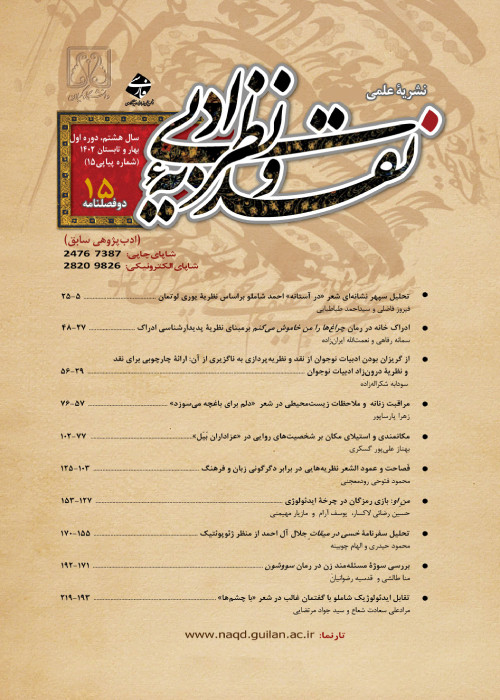The Impact of Setting and Location on the Fictional Characters of Qolam Hossein Saedi’s Azadaran-e Bayal
One of the functions of narrative setting is to prepare a platform to explain the personality and nature of the characters. Setting, ambiance, character features, and narration deepen the reader’s understanding of the text. This study investigates the process of locality and its connection to characters in Qolam Hossein Saedi’s Azadaran-e Bayal. The analysis is done through a combined narratology which employs relevant narratological theories. Through investigating the narrative setting, this study argues that the subjectivity of location has an everlasting impact on all narrative elements in the selected stories. Bayal functions as the macro text setting and habitat for the characters and reflects the influence of the setting on the psycho-sentimental ambiance of the narrative. The positioning of Bayal at the narrative locus of the eight stories comprises the symbolic aspect of a place which exposes the creativity of the author. The characters are placed in the setting and metamorphosed into it. To revive itself, each time Bayal sacrifices one of the disappointed, passive, and helpless characters. In the process of reading, the reader plays a complementary role in recreating the scenes and characters.
The element of place and its close connection with other elements of fiction necessitates the study of its representation in the narrative process. The study at hand investigates the subjectivity of place and its relation to narrative characters in Qolam Hossein Saedi’s collection of short stories called Azadaran-e Bayal (1346 [1967]). Its qualitative and quantitative impact has left its long-lasting mark on the characters of the stories. In some cases, place functions as a metonymy for the characters. For example, a character’s house becomes a continuum or extension of itself; thus, if the house is described, it seems as if the character (not the house) were being described (Wellek. 1373 [1994]: 12). Azadaran-e Bayal is among the outstanding literary works of the 1960s. It consists of eight interconnected stories which are set in a village called Bayal.
This study is done through a combined narratology which employs relevant narratological theories. By analysing the text in accordance with narratological patterns, the present article enters sub-textual levels such as narrative and character-place correlation. To understanding the text and discover new concepts that are pertinent to the subject matter at hand, this study also employs theories from Seymour Chatman, Gérard Genette, and Roland Barthes.
As an element of fiction, location is a space which hosts and presents the characters, events, and actions of the narrative. Narratology regards narrative setting as an element of modern narrative, and place as a platform which embodies time, characters, events, and relations in fiction. Seymour Chatman argues that the poetics of narration is the logical explication of the narrative structure, elements, composition, and systems of fictional elements (Chatman, 1978:3). Therefore, fictional elements create an organic unity. Since Aristotle, the narratological focus has been on studying time. Although this statement is true, one cannot ignore similar representations in time and place (Abbot, 1397 [2018]: 287).
In narratology, the narrative character is an important piece of the plot, and – just like time and space – is a crucial element of the fabric of fiction. Contrary to Chatman’s belief, the character is not a suspended and isolated being; as a matter of fact, she/he is the locus of the narrative. As long as the character is not bound to the central and marginal issues of the narrative, it possesses no identity of its own (Chatman, 1390 [2011]: 188). Structuralism categorises the character in accordance with binary opposition and highlights their contrasts. Scholes conceptualises the narrative character through individuation and type-formation. He argues that famous fictional characters who pass the test of time are the sum total of both (Scholes, 1968: 20).
Bayal, as the hotspot of all the events in Azadaran-e Bayal, is more than a place. It influences the characters’ traits, personality, and their actions. Bayal is a space that influences plot development and the characters’ narrative nature, and sets the mood of the narrative. Its importance is also captured in the title of the collection. The term “Azadari” [Mourning] gives a gloomy and tragic mood to the whole work. To describe the narrative setting, Saedi employs both direct and indirect descriptions. Also, by highlighting the equivocating details and location-based motifs, he creates the fictional character of Bayal that imposes its subjective authority on the stories (Butor, 1971: 88). Through a direct and vivid description, the first sentence of the first story introduces the setting of the text to the reader. The ambiance is interconnected with the whole narrative. The psychological and sentimental setting fuses with the real to suspend and relativise the setting and encourage the reader to find his/her position in the text. The unbiased third-person narrator narrates the dialogues, events, actions, and settings, and binds the settings and the characters.
By positioning Bayal in a narratological context and a psycho-sentimental location, this study illustrates Bayal as a fictional character who, with a dark heart, controls the lives of the villagers. In the character and place continuum, the characters are an extension of the setting. They are the side-effects of their existential residence place. The hatred and resentment engendered by the place and the psychotic mood leave their imprint on each of the characters, making them look strange and unpredictable. The setting of Azadaran-e Bayal’s creates spaces, scenes, ambiances, and environmental elements. Bayal sacrifices one character after each disaster. Those who survive, flee to the city, which is also an infected shadow of Bayal.
- حق عضویت دریافتی صرف حمایت از نشریات عضو و نگهداری، تکمیل و توسعه مگیران میشود.
- پرداخت حق اشتراک و دانلود مقالات اجازه بازنشر آن در سایر رسانههای چاپی و دیجیتال را به کاربر نمیدهد.


